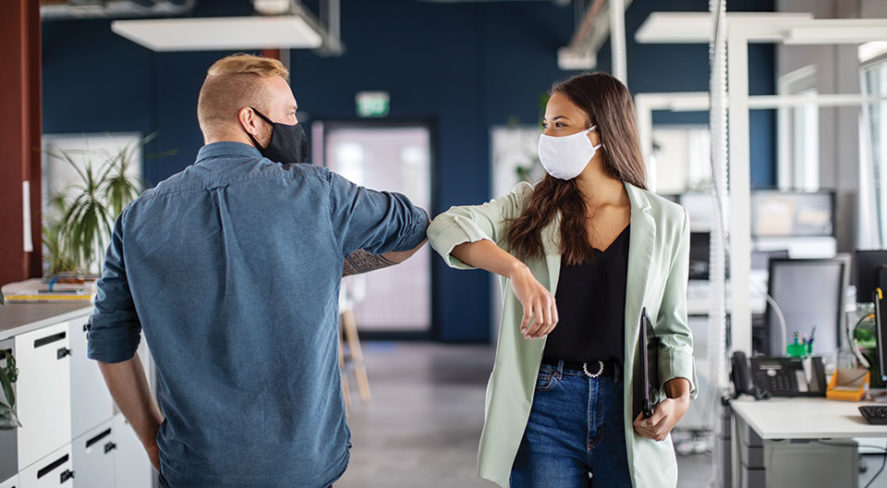Using Technology to Bring Employees Back Safely: Touchless Access Control and Other Solutions Enhance Both Security and Health


Will we ever return to the office for good? The rise of the Omicron variant and the pandemic’s rapid resurgence has forced companies to postpone office return dates. However, many companies will soon welcome people back, and they will need to address people’s safety concerns in the process.
A Gartner survey of global HR leaders found that more than three-quarters are hesitant to come back to the office because of health and safety concerns. That is why organizations must adapt to new workspace requirements, ensuring compliance with COVID-19 guidelines and leveraging technology to ensure safety. Access control applications, including touchless authentication, mobile credentials, and distancing analytics, can help businesses create a secure and healthy working environment for all employees.
Simply put, companies can leverage digital tools and novel technologies to create a safe back-to-work strategy as employees return to the workplace in 2022. Here’s how.
Touchless Technology for Hygienic Access Control
Key card access controls are ubiquitous in workplaces, securing facilities and employees with little friction or complication. However, the pandemic presents an opportunity to enhance these technologies by adopting touchless authentication to further reduce both friction and the risk of virus transmission.
High-touch contact points across the workspace, from employee workstations to conference rooms, can benefit from touchless authentication, which decreases cross-contamination by reducing contact with humans and objects. When coupled with enhanced cleaning regimens at these touchpoints, companies can best adhere to Centers for Disease Control and Prevention guidelines and shifting employee expectations.
Relying on multi-sensor technology, touchless authentication solutions can verify access credentials in real time without the user entering a code, swiping a card or touching a sensor. In addition, these technologies can easily check employees’ temperatures, denying entry to anyone showing a potential fever. Similarly, they can help companies detect if people are not wearing face masks where required.
For these reasons, developing touchless openings is a more hygienic and viable access control solution for many workplaces.
Face Credentials Combine Safety and Productivity
Contactless face credentials provide employees with quick and smooth access to the workplace while preventing fraudulent entries. Face authentication control systems will automatically allow access to the authorized person while notifying security of any unauthorized entry attempts. This eliminates the risk of a stolen or lost ID being used to access a workspace, or multiple people accessing it with the same card.
What’s more, companies can instantly issue secure face credentials to staff members, and these credentials can also be used to activate printers or create a frictionless environment at office cafeterias and vending facilities.
At the same time, touchless face authentication can be integrated into time management systems to improve workspace efficiency. This way, when employees and temporary staff (e.g., cleaners and contractors) pass through a biometric security checkpoint, the timesheet will automatically mark their attendance.
Distancing Analytics Help Maintain Compliance
Physical distancing can help slow and prevent the spread of coronavirus. Several technologies can encourage and enforce physical distancing, including:
- Video surveillance
- Occupancy management analytics
- Remote and/or scheduled locking and unlocking of spaces
When deployed effectively, these technologies encourage social distancing throughout an organization, helping companies maintain health and safety protocols and compliance measures and creating hygienic working conditions for all employees.
For example, security cameras equipped with social distancing features can help ensure occupancy management, social distancing and face covering compliance. With these tools, businesses can track the number of people entering and exiting a space, automatically restricting access when a predefined occupancy limit is reached.
Employee Safety Is the First Priority
The Omicron variant may have slowed the return to work, but offices will not be empty forever. As companies consider when and how to bring employees back to the office, safety must continue to be the top priority. Protocols alone cannot keep people safe from COVID-19, but the right tools can help employers address employee concerns before offices are reopened.
Modern technologies, such as touchless authentication, mobile credentials and distancing analytics, can help organizations provide a safe working environment, allowing their people to thrive in the office once again.
Tina D’Agostin (tina@alcatraz.ai) is the CEO of Alcatraz AI (alcatraz.ai).
